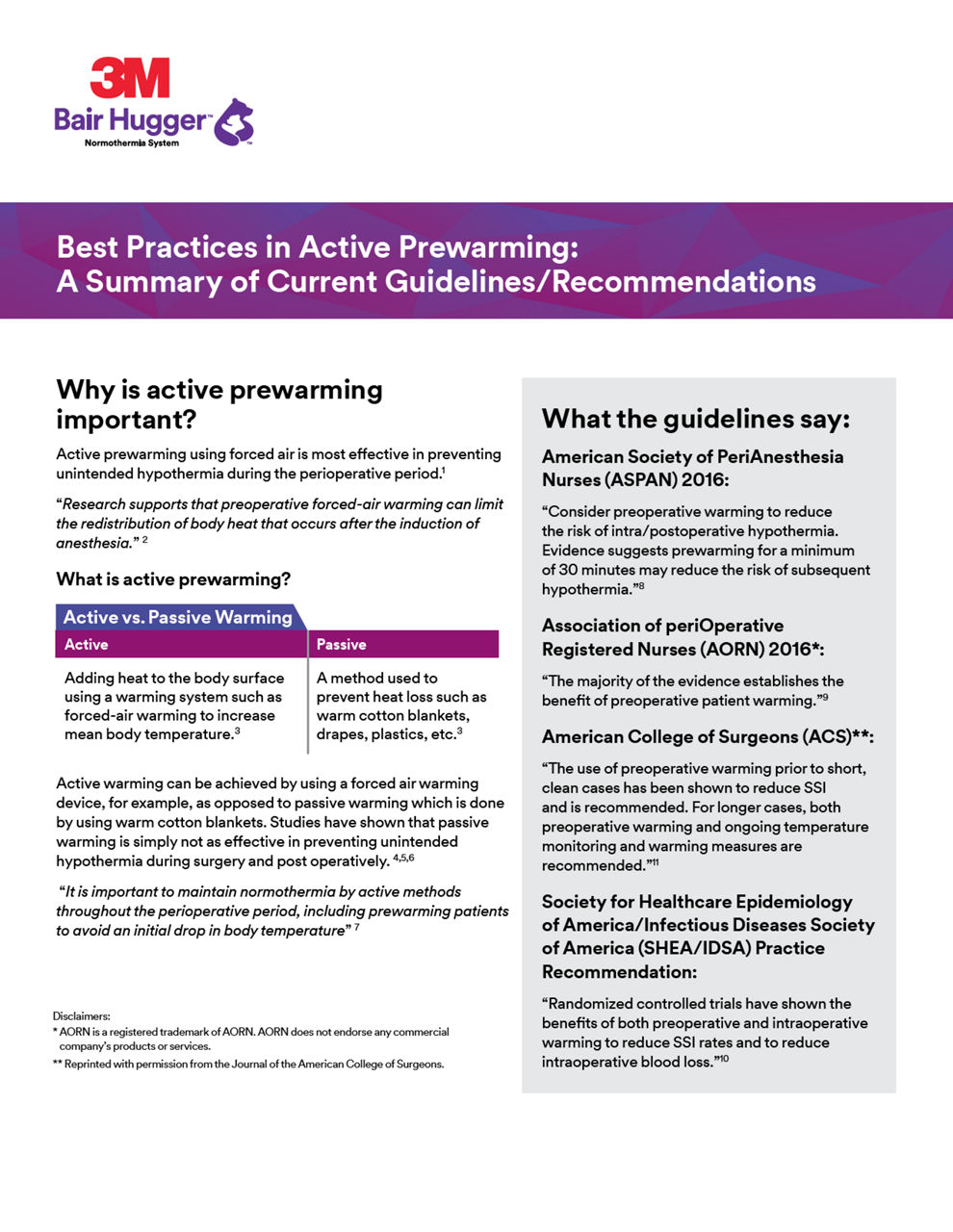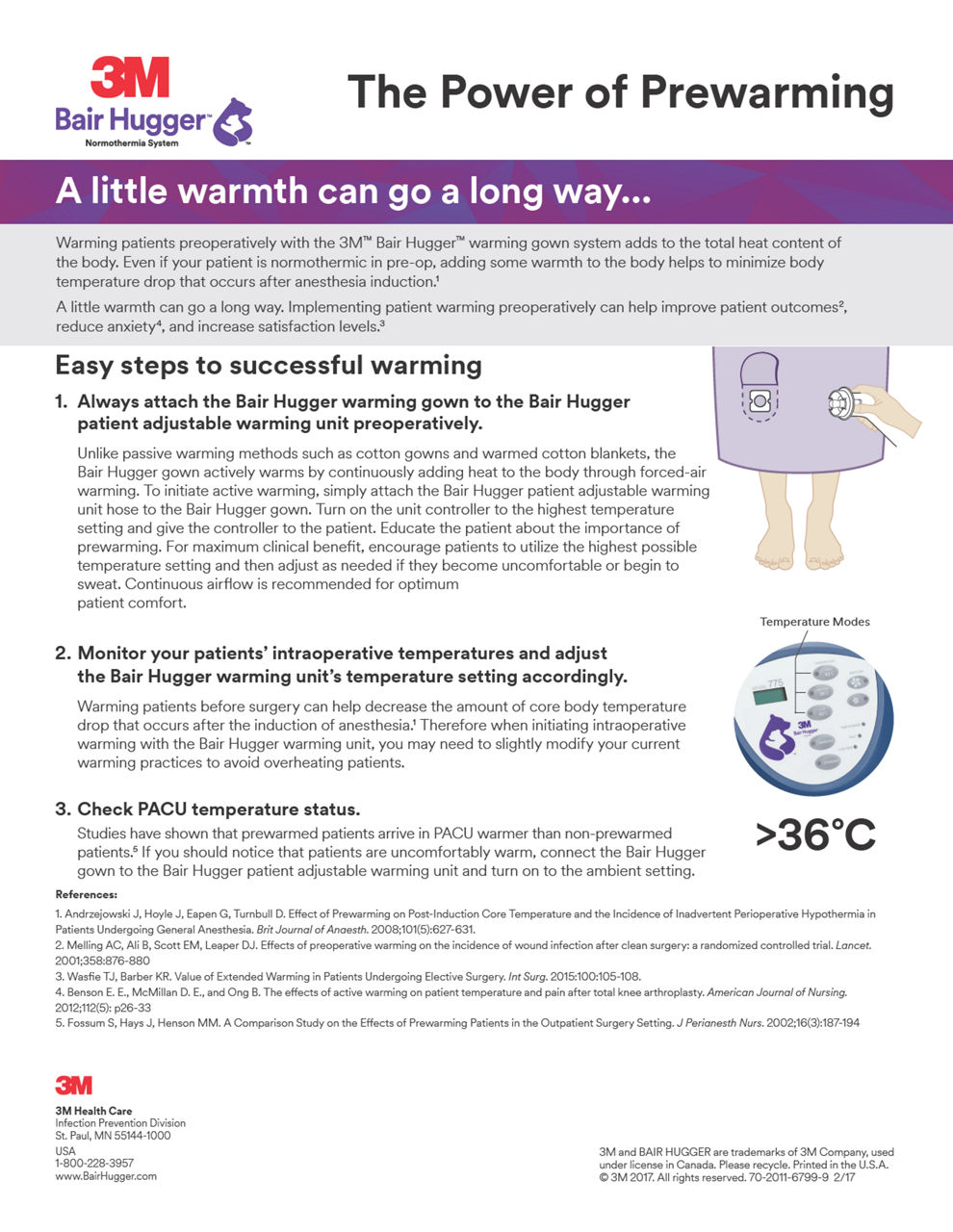Temperature management
Prewarming: A key to helping prevent hypothermia
A few degrees can make all the difference in helping to maintain normothermia. Any patient undergoing general or regional anesthesia is susceptible to perioperative hypothermia as their body’s response to temperature (thermoregulation) mechanisms becomes impaired. In fact, short durations of prewarming administered before anesthesia induction can help to reduce intraoperative heat loss.3

Effects of anesthesia on patient core temperature
During the first 60 minutes of anesthesia, research has shown that the core temperature for unwarmed surgical patients can drop up to 1.6°C,4 as anesthesia-induced vasodilation allows the body’s warmer blood to flow freely from the core to its cooler periphery.

Under normal circumstances, the body controls its temperature within a very tight tolerance, with its core 2°–4°C warmer than its periphery. This temperature gradient between the core and the periphery is caused by normal thermoregulatory vasoconstriction.

Anesthesia causes vasodilation, which allows the warmer blood to flow freely from the core and mix with the blood from the cooler periphery. As the blood circulates, it cools until returning to the heart, causing a drop in core temperature. This drop in temperature is called a redistribution temperature drop (RTD).

Prewarming with forced-air warming can increase the temperature of the body’s peripheral tissues, limiting the amount of heat lost from the core through RTD. The warmer periphery limits the blood’s rate of cooling and allows the blood to return to the core at a higher temperature.
Key benefits of prewarming
Prewarming with 3M™ Bair Hugger™ Warming Blankets or Gowns can help:
- Reduce core temperature drop by decreasing the core‑to‑periphery temperature gradient
- Maintain normothermia, in conjunction with intraoperative warming, which can reduce the rate of numerous complications, including surgical site infections (SSIs)5,6
- Proactively warm your patient’s periphery, before the induction of anesthesia, banking heat to help ward off heat loss due to RTD
- Improve patient satisfaction
Maintaining normothermia can help reduce risk
The maintenance of a normal core body temperature, normothermia, is a crucial component of patient safety. Core temperatures outside the normal range can pose a risk in all patients undergoing surgery and have been associated with an increased risk of surgical complications, including:

Improve outcomes, reduce costs
Helping patients maintain a normal core body temperature is key to improving surgical outcomes and reducing or eliminating costs linked to hypothermia-related complications.
3M Bair Hugger warming system helps to maintain normothermia which can reduce the risk of complications associated with hypothermia.
$66 Average cost of an operating room minute16 | $203 Mean acquisition cost of a unit of blood19 | $25k Average cost of a surgical site infection21 | $14.67 Average cost of cotton blanket per surgical patient23,24 | $1,629 Average cost per inpatient day26 | $10 Average cost per post-anesthesia care unit minute27 |
|
|
|
|
|
|
Effective temperature management solutions
To help you maintain normothermia
We want to help you restore patients’ lives for the better. So, we listen closely to understand your toughest challenges, then find new ways to create innovative temperature management solutions so you can provide more efficient care.
That’s why we’ve designed a wide range of solutions including the 3M™ Bair Hugger Temperature Monitoring System, 3M™ Bair Hugger Warming System, 3M™ Ranger Blood/Fluid and Irrigation Fluid Warming Systems and Pressure Infusors aimed to help you maintain normothermia, create positive patient experiences and improve surgical outcomes.
References:
- Forstot RM. The etiology and management of inadvertent perioperative hypothermia. J Clin Anesth. 1995;7:657-674.
- Leslie K, Sessler DI. Perioperative hypothermia in the high-risk surgical patient. Best Pract Res Clin Anaesthesiol. 2003;17:485-498.
- Horn EP, Bein B, Bohm R, Steinfath M, Sahili N, Hocker J. The effect of short time periods of pre-operative warming in the prevention of peri-operative hypothermia. Anaesth. 2012;67(6)
- Hooven K. Preprocedure warming maintains normothermia throughout the perioperative period: a quality improvement project. JoPAN. 2011;26910:9-14
- Kurz A, Sessler DI, et al. Perioperative Normothermia to Reduce the Incidence of Surgical-Wound Infection and Shorten Hospitalization. New Engl J Med. 1996;334:1209-1215.
- Melling AC, Ali B, Scott EM, Leaper DJ. Effects of preoperative warming on the incidence of wound infection after a clean surgery: a randomized controlled trial. Lancet. 2001;358(9285):876-880.
- Schmied H, Kurz A, et al. Mild hypothermia increases blood loss and transfusion requirements during total hip arthroplasty. The Lancet. 1996;347(8997):289-292.
- Rajagopalan S, et al. The Effects of Mild Perioperative Hypothermia on Blood Loss and Transfusion Requirement. Anesth. 2008; 108:71-7.
- Bush H Jr., Hydo J, Fischer E, et al. Hypothermia during elective abdominal aortic aneurysm repair: The high price of avoidable morbidity. J Vasc Surg. 1995;21(3): 392-402.
- Frank SM, Fleisher LA, Breslow MJ, et al. Perioperative maintenance of normothermia reduces the incidence of morbid cardiac events. JAMA. 1997;277:1127-1134.
- Scott AV, Stonemetz JL, Wasey JO, Johnson DJ, Rivers RJ, Koch CG, et al. (2015) Compliance with Surgical Care Improvement Project for Body Temperature Management (SCIP Inf-10) Is Associated with Improved Clinical Outcomes. Anesth. 123: 116–125.
- Fossum S, Hays J, Henson MM. A Comparison Study on the Effects of Prewarming Patients in the Outpatient Surgery Setting. J PeriAnesth Nurs. 2001;16(3):187-194.
- Wilson L, Kolcaba K. Practical Application of Comfort Theory in the Perianesthesia Setting. J PeriAnesth Nurs. 2004;19(3):164-173.
- Schroeck H, Lyden AK, Benedict WL, Ramachandran SK. Time trends and predictors of abnormal postoperative body temperature in infants transported to the intensive care unit. Anesthesiol Res Pract. 2016;7318137. doi:10.1155/2016/7318137.
- Hooper VD, Chard R, Clifford T, et al. ASPAN’s evidence-based clinical practice guideline for the promotion of perioperative normothermia: Second edition. J Perianesth Nurs. 2010;25(6):346-365. doi:10.1016/j.jopan.2010.10.006.
- Shippert, R. Am Journal Cosmetic Surg. 2005;22(1):25-34.
- Yilmaz, M. et. al. Anesth. 2008;109 Abstract 880.
- Andrzejowski, J. et. al. BJA. 2008;101(5):627-631.
- Shander, A. et. al. Transfusion. 2010;50:753-765.
- Mahoney, CB. Odom, J. AANA J. 1999;67(2):155-164.
- Stone, P. AJIC. 2005;33(9):501- 509.
- Kurt, A. et al. N Engl J Med. 1996;334:1209-15
- VPMR survey results. Warming Methods Cost Comparison Research, sponsored by 3M July 2012.
- The Key Group survey results. Hospital Linen Usage and Cost Analysis Survey, sponsored by 3M November 2011.
- Senn, Girard F. Surg Serv Management. 2002; 8:19-2S
- Oh,1. ASC Communications 2012. April 30, 2012. Source: Kaiser State Health Facts.
- Steinriede, K. Outpatient Surg. October 2010.






